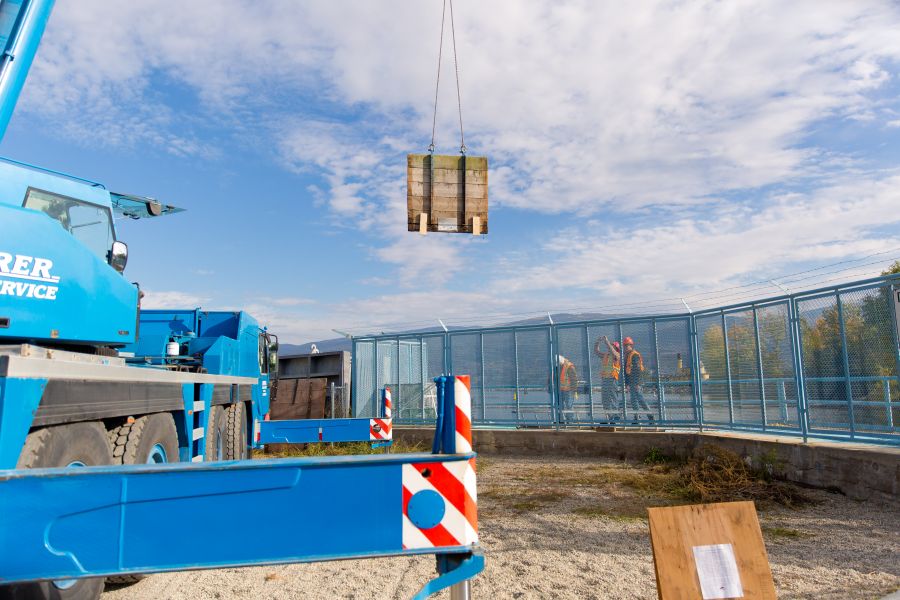For the very first time since the Penticton Dam was built in 1953, spawning sockeye salmon can now enter their old stomping grounds of Okanagan Lake.
The historical opening occurred at 10:30 am on Wednesday, when a mobile crane removed a wooden gate at the top of the dam's just-revamped fish ladder.

The ladder, which was built into the dam during its construction but left inoperable since, had been fully restored over the course of the past week. All that remained yesterday, in theory, was to lift the top gate and let gravity take over.
But theory, unfortunately, isn't always perfect. With the gate lifted, the flow of water wasn't as great as anticipated. So the crane was called back into action once more to remove a second section, which did the trick.

The importance of the ladder opening cannot be overemphasized. The Okanagan sockeye, which, according to Okanagan Nation Alliance member and project fisheries biologist Ryan Benson, makes up nearly 90 percent of the critical Columbia River sockeye run, was almost wiped out in the latter half of the last century.
For that, you can blame careless human progress. A flurry of dam building and river channelization throughout the Columbia River Basin suddenly meant the sockeye couldn't access its historical breeding grounds, BC's Okanagan Valley, and the resulting die-off was monumental.
The Indigenous people of the Pacific northwest were the first to raise the alarm, and thankfully in time that alarm was heeded. In the last couple decades, waterways have been de-channelized, natural habitats have been restored and dams have been tweaked to allow passage.

In the years since, the sockeye resurgence has been nothing short of spectacular. Able once more to swim to the Okanagan, they've proliferated.
They've also continued their march northward. In 2009, McIntyre Dam near Oliver was fitted with gates to allow them through. In 2013, the dormant fish ladder built into Skaha Lake Dam was reactivated.
Locally, 2018 was a banner year for the sockeye and nowhere was that more evident than the Penticton River Channel. Led by the Okanagan Nation Alliance, the channel had been dredged and rebuilt in many spots with low-flow zones and gravelly spawning beds. And now the fish were hitting it hard.

"We started monitoring the channel back in 2003," said Ryan Benson Tuesday afternoon. "The first confirmed sockeye was in 2011. Last year we hit 24,000, which is a record."
Yet many of the sockeye wanted to spawn even further north. Increasingly, they were spotted swirling about at the base of the Penticton Dam. Many had undoubtedly come from the Penticton Indian Band's k] cp?’lk’ stim’ Salmon Hatchery fry release program, which began in 2014 and focused on Okanagan Lake.
In many ways, it never made more sense to open the ladder, but one hurdle remained.

As was the case at other points downstream, it was thought that once introduced, the sockeye would compete for food and act as predators or prey for other native fish.
However, after a long study and a good look at the sockeye's impact on Skaha Lake, it was decided that reintroducing sockeye wouldn't trigger an ecological nightmare and the project was on.
All of that brings us around to Wednesday's opening. Watching the event and conducting a "Salmon Ceremony" just before the water began to flow was PIB elder, knowledge keeper, and salmon keeper Richard Armstrong.

To say he was moved is understating things. The Okanagan sockeye had always played an integral role in the band's way of life, and their near extinction hit them brutally hard.
"I'm so glad to be alive to see this day happen," he said afterward. "It's incredible to see the fish pass through here. This hasn't happened since the 40s or 50s. To be witnessing that, I can't find the words to express how deeply it touches me."
According to Armstrong, there was a time when band members rode on horseback into the river, when it was naturally serpentine, long before its channelization and Okanagan Lake damming, to spearfish sockeye weighing as much as 40 or 50 pounds.

"That memory of harvesting the river the way it should be harvested, selectively, without nets, stays with me," he said.
Today, Armstrong is hopeful.
"I think that in this day and age, environmentalists and agencies are finally realizing how important it is to talk to the Indigenous people. Our knowledge goes back farther than anything they can get out of books."
Also on hand Wednesday was Cawston's Lee McFadyen, a member of the Okanagan River Restoration Initiative. McFadyen was scheduled to be at the dam anyway, teaching a class of elementary school children about the river, when she saw the ladder opening was coincidentally set to occur at the same time. She was thrilled.

Staring at a grouping of a dozen or so sockeye milling at the base of the dam, mere meters from the just-opened ladder, McFadyen said that it was "just incredible luck for these children to be here on this momentous occasion."
"I explained to the kids that since their grandparents were small children there hasn't been sockeye in Okanagan Lake, and how they'll be able to tell their kids in the future that they were here on this day.

"I have to take my hats off to the Okanagan Nation Alliance and the fisheries department for pushing this through."
Project engineer Doug Edwards said the team, made up primarily of Okanagan Nation Alliance and Fisheries and Oceans Canada members, was happy with the water flow, but he cautioned there was much more ahead.

"Now we're talking about our follow-up work," said Edwards. "We have to measure flows and stuff like that, then we'll do a final drawing for future use."
"This is really just a test for next year. We have to discuss if we need to do any modifications. One thing we're talking about is putting in a valve system at the top end to control the levels rather than having to send people here to put in stoplogs all the time.

"We also need to discuss its operation," Edwards continued. "Do we want to leave it like this all year long? In the summer, the water level comes up quite a bit, so we might have a lot of water going through here."
Ryan Benson, a guy who wore a trail into the ground Wednesday running back and forth from the ladder's upper gate to its outflow, shared Edwards' view to the future.

"The whole point now is to test how everything flows through here," he said, "and then ideally we'll have an idea how to make it better. Right now we just don't know."
"But the experiment this year is to put in a hundred sockeye. We'll have a net pen, so they won't be able to swim through until we tag them with fluorescent tags. We'll tag a hundred and put them up and over and see where they end up."

Then, he said, they'll shut it down until next year.
He explained that "2020 will be big. In 2016, we had really big hatchery production, a record egg production since the program started. They'll be returning next year, and we want to have everything in place."
He also enlightened PentictonNow as to who's footing the majority of the bills.

"The Washington State Grant and Chelan County PUD (Public Utility Districts) have been funding pretty much all of this. When they built their dams, there were no environmental regulations, so they need to mitigate the impacts of their dams by having hatcheries and producing fish."
To Benson, like Armstrong, today held deep personal and societal significance.
"My children, they're Lower Similkameen Indian Band, and all the stuff I do, I do for my kids. This has been a long time coming. A lot of work, a lot of dealing with agencies. But getting to the point where we're actually doing it is pretty profound."



















